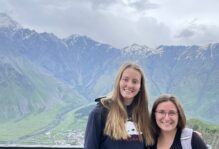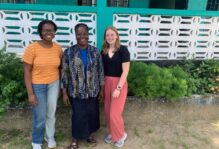A Noteworthy Summer Exploring Hydropower Development in Nepal
By Kritika Jothishankar ’25
The Global Research Institute’s Summer Fellows Program provides international experiential learning opportunities to W&M students. This post is one installment of a series highlighting the 2023 Fellows’ key discoveries and formative experiences.
The first time I video chatted with my would-be host family in Kathmandu, I was anxious about meeting and living with a family I had never interacted with. The day I entered the gates to the housing colony, I was nervous about how they would perceive me — a stranger. But by the time I left, all those nerves had disappeared, and these people had become family to me. My time in Nepal was full of laughter, excitement, and curiosity because of the people I met, who showed me that the best and most memorable adventures often come alongside pushing past your boundaries.

A view of Kathmandu Valley from the housing colony that Kritika and Sarah’s host family lives in.
Before my seven weeks in Nepal, my research experience was primarily quantitative and mainly involved data analysis. I wanted to work as a GRI Summer Fellow to get more qualitative work experience abroad in economic development. I got this opportunity during my seven weeks in Nepal while working as a Research Assistant for Professor Nara Sritharan for the Nepal Water Initiative project (NWI). NWI is a multidisciplinary project, convening partners from W&M’s Virginia Institute of Marine Science (VIMS), Institute for Integrative Conservation (IIC), the Religious Studies Department, and GRI’s AidData. My co-fellow, Sarah Wozniak, and I are working to understand the economic impact of the geopolitics between India and China on Nepal’s growing hydropower sector. In Nepal, we interviewed prominent public officials, locals, journalists, nonprofits, and other experts about their opinions on hydropower development. Going into these interviews, I didn’t anticipate all the moving pieces in Nepal’s hydropower sectors.
While government officials explained laws currently in place to promote hydropower development, private sector experts discussed government-induced barriers to investment, and journalists analyzed the limitations India and China’s geopolitics place on Nepali economic policy. Meanwhile, locals and activists brought up environmental concerns and social barriers due to unequal distribution of electricity based on socioeconomic status. Each person we interviewed added another view of looking at Nepal’s current hydropower development. Though these perspectives at times could seem conflicting, all our interviewees agreed on one point: The government of Nepal needs a long-term vision for what it wants its country to become.

Kritika, Sarah, and their fellow intern in front of the Nepal Parliament building as part of a trip with the Institute for Integrated Development Studies (IIDS) team.
From our in-country research, we had three major takeaways about foreign investment in Nepal’s hydropower sector. First off, domestic politics and political instability results in complicated bureaucratic procedures that make investors turn away from Nepal. Next, Nepal has to strategically balance its position between India and China to manage foreign relations while reducing dependency on its neighbors, specifically India. Lastly, Nepal should be the main consumer of its own electricity, meaning that the government should focus on creating policy and infrastructure that builds a robust domestic market for electricity, instead of relying on exporting electricity.
From our interviews, I was particularly eager to learn more about industry development in Nepal, and I wanted to talk to more Nepali economists and researchers about their observations for industry growth. One of the places I was able to do this was at the Institute for Integrated Development Studies (IIDS) in Kathmandu. In addition to working on NWI with Professor Sritharan, Sarah and I also interned for IIDS. At IIDS, I worked as an economic policy intern and contributed to reports summarizing Nepal’s capabilities for industry development within the Information, Communications, and Technologies (ICT) industry. Interning at IIDS allowed me to learn more about industry growth, but also gave me insight into the average Nepali workday. I chatted with interns about cricket and the best places to visit in Kathmandu over a cup of tea or discussed the NWI project and got resources recommended by Program Officers to read or watch over an office-provided lunch of Dhal Bhat. The open and inviting environment of IIDS showed me the importance of multidisciplinary development research in-country collaborators.
My time in Nepal, though, was not only about research. It was also about my everyday experiences. After work, Sarah and I were eager to find a new place to visit in Kathmandu. We explored the Durbar Squares in Kathmandu, Patan, and Bhaktapur. We finished work for NWI or IIDS at our host family’s café, WakeCup Coffee, in Lalitpur. We ate bowls of Thukpa and plates of Chataamari next to windows facing the busy streets of Thamel Marg. We explored the city by running errands for our host family — whether buying chart paper for our host sister’s school project on the water cycle, hunting for reasonably priced batteries at tech shops under the guidance of our host mom, or collecting a box of mangoes for our host sisters. I was learning that little tasks I barely thought about at home felt like tremendous accomplishments abroad.

Kritika and Sarah celebrate their host mom’s anniversary by surprising her with a red velvet cake.
In addition to these little accomplishments, I accomplished a couple of firsts. On a visit to Pokhara, Sarah and I hiked for two days to the Australian Base Camp, where we saw the breathtaking Annapurna Mountain range for the very first time. Our guide on the trek was a friend of our host family who talked to us for two days straight, answering our numerous questions and saving us from falling and slipping on mud. It even turned out that we all have a connection to Williamsburg. Our guide is a partner in the Academy of Coffee Excellence Nepal, which organizes coffee education programs and trains baristas. Coincidentally, it’s a branch of the Academy of Coffee Excellence located in Williamsburg, VA. While visiting Chitwan, we saw one-horned rhinos and a sloth bear on my first safari. I also crossed off a bucket list item and bungee jumped in Nepal.
My time in Nepal would not have been complete without the people I met along the way. From the before-work Nani & Babu nursery rhyme singalongs with my one-year-old host sister to the rigged claw machine at Funland with my eight-year-old host sister to the motorcycle trips with our host mom to eat sweets at Tip Top Sweets, each person I met encouraged me to experience something new and to be inquisitive about my new surroundings. I learned that pushing my boundaries and embracing new experiences was the best way to learn about those around me and experience Nepal in its entirety.
Now back in Williamsburg, Professor Sritharan, Sarah, and I are continuing our work on the Nepal Water Initiative by compiling our research into reports and memos analyzing the many perspectives on the geopolitics behind hydropower development in Nepal, with the goal that our research prompts policy changes in Nepal and encourages multidisciplinary research to continuously provide more holistic development solutions past just our time on NWI.




No comments.